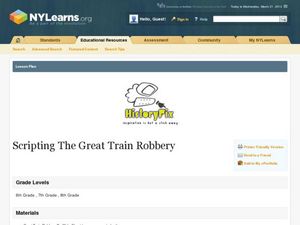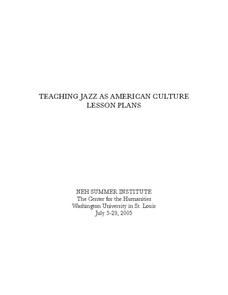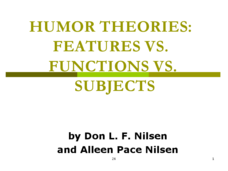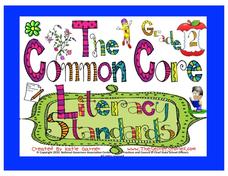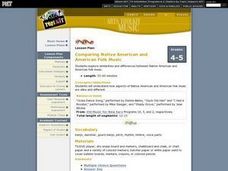Global Oneness Project
Flamenco: A Cross-Cultural Art Form
Notes of pride and persecution, exclusion and isolation resonate in flamenco. Introduce this musical art form to your social studies or Spanish language classes with a resource that follows a young flamenco guitarist as he practices his...
Curated OER
Scripting The Great Train Robbery
Take writing prompts to another level in this activity, which allows pupils to create scenes of dialogue based on the 1903 silent film, The Great Train Robbery. Useful for a language arts/history cross-curricular activity, the lesson...
Canada's National Arts Center
Vivaldi and The Four Seasons
Did you know that Vivaldi’s orchestra was largely made up of girls from an orphanage? Fun facts like this fill a 34-page teacher's kit designed to accompany a cross-curricular study of Vivaldi's The Four Seasons.
Washington University in St. Louis
Teaching Jazz as American Culture
Jazz and the City, Jazz and the Civil Rights Movement, Jazz and Gender, Jazz and Literature, Jazz and the Arts, Jazz and Film. Here's a packet of unit plans organized around themes that reflect American culture. Each unit examines how...
EngageNY
Grade 10 ELA Module 1: Unit 3, Lesson 6
Amy Tan's The Joy Luck Club brings together the central ideas of identity, ambition, expectations, and relationships. As high schoolers read an excerpt from the chapter "Two Kinds," they note how Jing-Mei's connection to music relates to...
Curated OER
Keyboarding - Story Grafting
Bring some humor and fun to your keyboarding or language arts class! Middle and high schoolers begin a story in response to a prompt and then move from keyboard to keyboard, continuing to add to the story while the monitor is turned off....
Curated OER
Humor Theories: Features vs. Functions vs. Subjects
Great for a psychology, sociology, or language arts lecture, this presentation focuses on the features, functions, and subjects of humor. Complete with definitions and examples of each category, as well as links to humorous videos and...
Curated OER
Metaphor Meanings
Help your young writers decipher the literal meanings of metaphors. After reading several metaphors, learners write the real meanings that the phrases are describing. Use this resource in a figurative language lesson, or when preparing...
E Reading Worksheets
Idioms
This idiom learning exercise will give your reluctant grammarians a change of heart about figurative language. Scholars read 15 sentences and then write the meaning of the idiom and the sentence in the space provided.
Curated OER
Paired Conjunctions
Learners identify parallel parts of sentences, meaning of sentences, and determine positive, negative, and choice conjunctions. Conjunction identification is the main focus of this language arts worksheet.
Curated OER
The Common Core Literacy Standards - Grade 2 Posters
Support second graders with mastering the Common Core using this series of classroom displays. With each English language arts standard rewritten as a We can statement and accompanied by images and examples, this resource provides young...
University of Texas
Essential Reading Strategies for the Struggling Reader
Beneficial for beginning readers, struggling readers, and those in need of review, a set of language arts activities is a great addition to any foundational reading unit. Focusing on phonological awareness, fluency, instructional...
Curated OER
Playing Music
In this music vocabulary worksheet, students use a word bank of 6 words (sing, clap, play, tap, listen, dance) to fill in 6 sentences.
Curated OER
New York State Testing Program English Language Arts Test Book 2--Grade 8 (2009)
In this New York State Testing Program English Language Arts worksheet, students listen to an article and answer reading comprehension questions. Students compose an essay using information from the article.
Curated OER
Thomas Hart Benton: The Sources of Country Music
Students examine artwork by Thomas Hart Benton. In this interdisciplinary lesson, students analyze the painting The Sources of Country Music, listen to folk music, and examine how recording technology and the movies shaped the images of...
Curated OER
Comparing Native American and American Folk Music
Students examine how aspects of Native American and American folk music are alike and different. They contrast both forms of music and engage in many activities to identify or explain how music fulfills a variety of purposes.
Curated OER
First Grade Language
In this language arts worksheet, 1st graders answer multiple choice questions about abc order, punctuation, correct sentences, and more. Students complete 25 multiple choice questions.
Curated OER
Third Grade Language
In this language arts worksheet, 3rd graders answer multiple choice questions about types of sentences, subjects, compound words, predicates, and more. Students complete 25 questions.
Curated OER
What Is Legal With Music On The Web?
Students research what is legal now as far as downloading music from the Internet. They also gather information now that some citizens have been charged with crimes. The research allows students to form informed opinions that are educated.
Curated OER
Modernism in Poetry, Painting, and Music
Are you teaching Modernism to your class? Connect different areas of artistic expression in the Modernist Era. Learners read T.S. Eliot, view art by Pablo Picasso, and listen to a Modernist musical composition. This final assignment is...
Curated OER
What Does Art Sound Like?
Help your charges investigate visual art by identifying sounds that are associated with the images. They view art galleries online and discuss which sounds would be present if the image was a real life situation. Additionally, they...
Curated OER
Boombox Classroom: Music and Language
In this music and speech worksheet, students find similarities between language and music. Students also tell about their own language. Students also may write the 7 music letters.
Curated OER
Sondheim: Voice of Cultural Change
High schoolers explore Stephen Sondheim's contributions to musical theatre in the context of the dramatic cultural shift that occurred in American life in the late 1950s, 1960s, and 1970s.
Poetry4kids
How to Write an Alliteration Poem
Learners follow five steps to compose an alliteration poem. They choose one consonant and brainstorm as many nouns, verbs, and adjectives they can think of to create rhyming sentences that come together in a poetic fashion.
Other popular searches
- English Language Arts Music
- Music and Language Arts
- Language Arts Musician
- Language Arts Music Theme
- Music Language Arts
- Music With Language Arts
- Art and Music Language Arts
- Music Language Arts Tiered
- Rap Music Language Arts
- Music Language Arts Teired



